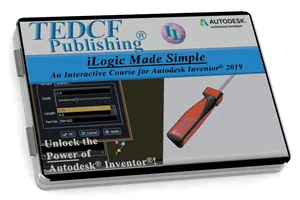iLogic creates parts, assemblies, and drawings with a click of a button. This course shows you how!
Want to learn a fast way to automate the construction of models, assemblies, and drawings? All you need to do is learn a few simple iLogic concepts and you're on your way. You need to have the strong foundation of advanced skills taught in the first 6 courses, but you can master iLogic even if you don't have programming experience. The Inventor 2019: iLogic Made Simple course goes far beyond any training on the market today, but simplifies the process so that anyone can do it.
iLogic creates parts, assemblies, and drawings with a click of a button. This course shows you how!
The most common question regarding iLogic is, “Do I need to use it?” The best way to answer this question is to learn how it works, and the simplest and fasted way to do this is to watch this course. It shows you all the steps and breaks it down into simple to understand concepts.
Do you need to be a programmer to use iLogic? No, while a programming background is helpful, it is not necessary. This course simplifies the programming process so that anyone can successfully produce iLogic scripts. So don't be discouraged if you're not a programmer.
So what does iLogic do? iLogic uses basic scripting language to execute commands. For example, you know the sequence of events that need to occur to create an extrusion. First you create a sketch with a profile, and then you extrude the profile a specific distance. iLogic gives you the ability to execute these steps with a single command. So it's a method of automating the execution of commands.
It might sound complicated, but it really isn't. With a little practice and clear descriptions of your goals and how to accomplish them, you'll easily master it.
68 Lessons & 67 Tips (Listed Below)
6.5 hours of instruction
You can also browse through the lessons from the following Inventor 2019 courses and watch sample lessons.
Inventor 2019: Solid Modeling Inventor 2019: Assemblies and Advanced Concepts Inventor 2019: 2D Drafting and Customization Inventor 2019: Sheet Metal Design Inventor 2019: Tube and Pipe Routed Systems Inventor 2019: Inventor Studio Made Simple Inventor 2019: iLogic Made Simple Inventor 2019: Fea Made Simple Inventor 2019: Dynamic Simulation Made SimpleOur Inventor courses require No Installation. You can watch them on any device connected to the internet.
You will receive an email containing your User Name and Password. Login to your account and start learning. It's that easy.
While you're logged into your account you can download files used in the courses, watch lessons, and practice the tasks taught in the lessons. Keep in mind that you will use your installation of Inventor to practice.
Get your Inventor 2019 training now. You can start learning in minutes.
Autodesk Inventor® 2019:
iLogic Made Simple
No Installation Required
Watch from any device connected to the internet.

$59.95 - $229.95
Watch Sample Lessons
Watch the first hour of the Solid Modeling course for Autodesk Inventor 2019.
 Click to Watch!
Click to Watch!iLogic Made Simple
6.5 hours of instruction
Lessons
Introduction
ILMS-Tip-1
iLogic Parameters
ILMS-Tip-2
Preparing Parts for iLogic
ILMS-Tip-3
iLogic Rule Basics
ILMS-Tip-4
iLogic Suppression
ILMS-Tip-5
Reusing Code
ILMS-Tip-6
Strategy for Using iLogic
ILMS-Tip-7
Mastering Snippets
ILMS-Tip-8
iLogic Assemblies
ILMS-Tip-9
Linking Imported Parameters
ILMS-Tip-10
Troubleshooting Rules
ILMS-Tip-11
Working with String Parameters
ILMS-Tip-12
Mastering Case Statements
ILMS-Tip-13
Expanding Rule Functionality
ILMS-Tip-14
Nested Case Statements
ILMS-Tip-15
iLogic Forms
ILMS-Tip-16
Creating iLogic Forms
ILMS-Tip-17
Configuring Controls
ILMS-Tip-18
Filename Parameters
ILMS-Tip-19
Linking Filename Parameters
ILMS-Tip-20
Control Testing Strategies
ILMS-Tip-21
Automatically Save Files
ILMS-Tip-22
Point Assembly to Component Files
ILMS-Tip-23
Replacing Parts with iLogic
ILMS-Tip-24
Master Rules
ILMS-Tip-25
Algorithms
ILMS-Tip-26
Triggers
ILMS-Tip-27
Redundant Files
ILMS-Tip-28
Pre-Existing Files
ILMS-Tip-29
Building Descriptions and Titles
ILMS-Tip-30
Snippet Workflow
ILMS-Tip-31
Opening Excel Files
ILMS-Tip-32
While Loops
ILMS-Tip-33
Populating Excel Worksheets
ILMS-Tip-34
Updating Master Rules
ILMS-Tip-35
Multi-Line Messages
ILMS-Tip-36
Searching Tables
ILMS-Tip-37
Trick for Stopping Rules
ILMS-Tip-38
Preventing Duplicate Records
ILMS-Tip-39
Stopping Error Messages
ILMS-Tip-40
Updating Assembly Components
ILMS-Tip-41
Cleaning Up Your Code
ILMS-Tip-42
Building Assemblies and Testing
ILMS-Tip-43
Automating Mechanical Drawings
ILMS-Tip-44
Testing Rules on Drawings
ILMS-Tip-45
Control Section Cutting Lines
ILMS-Tip-46
Break Views and Detail Circles
ILMS-Tip-47
Automating Broken Views
ILMS-Tip-48
Broken View Rule Details
ILMS-Tip-49
Break Multiple Views
ILMS-Tip-50
Dimensions on Suppressed Features
ILMS-Tip-51
Determining Rule Placement
ILMS-Tip-52
Using Shared Variables
ILMS-Tip-53
Robust Shared Variables
ILMS-Tip-54
Testing Shared Variable Rules
ILMS-Tip-55
Running idw Rules from Assemblies
ILMS-Tip-56
Saving Drawing Files
ILMS-Tip-57
Change View File Reference
ILMS-Tip-58
Update Reference File
ILMS-Tip-59
Passing iProperties and Parameters
ILMS-Tip-60
Replacing Drawing References
ILMS-Tip-61
Assembly Drawing Rules
ILMS-Tip-62
Passing Assy to Drawings
ILMS-Tip-63
One Click Assy Parts & Drawings
ILMS-Tip-64
Creating Input List Radio Boxes
ILMS-Tip-65
External Rules
ILMS-Tip-66
Global Forms
ILMS-Tip-67
Conclusion
